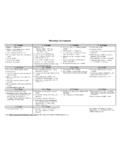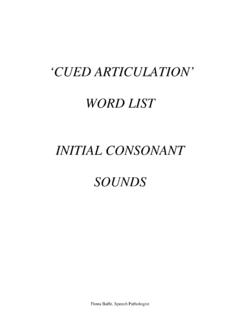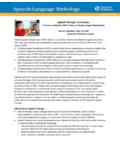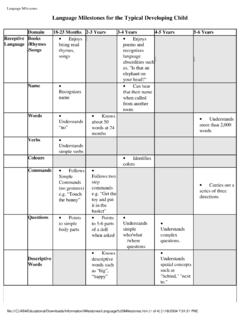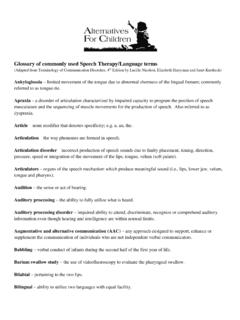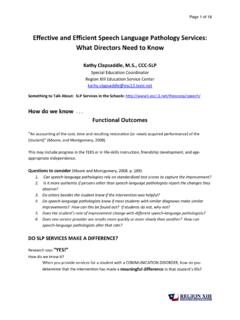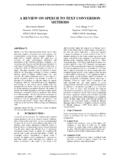Transcription of Phonology Development Chart - St. Rita School for the Deaf
1 Phonology Development 0 - 3 Months 3 - 6 Months 6 9 Months 9 12 Months Birth cry undifferentiated Reflexive sound making produces glottal catch and vowels (ah, eh, uh) Some variety in non-crying sounds Differentiated cry (true vocal communication begins) Coos and gurgles Produces single syllables Begins blowing bubbles Babbling begins Double syllables VCV, aga Puts lips together says m Nasal tone is heard Vocalizes pleasure and displeasure Stops vocalizing when adult enters Self-initiated vocal play Coos, chuckles, gurgles and laughs Babbles to self, others, and objects Babbling show pitch and inflection change Vocally expresses eagerness Uses m, n, t, d, b, p.
2 Y in babbling multiple syllables Babbles tunefully singing tones Uses wide variety of sound combinations including non-English sounds Inflected vocal play intonation patterns heard Imitates intonation and speech sounds in his/her own repertoire Reduplicative babbling begins bababa Vocalizes during play Vocalizes to mirror Jabbers loudly wide variety of sounds and intonations Uses most sounds (C&V) in vocal play beginning of phonetic drift May acquire first true word 0-18 months Variegated babbling begins combines different syllables in vocal play 1 1 Years 1 - 2 Years 2- 2 Years 2 - 3 Years Uses sentence-like intonations (jargon) Some echolalia Uses most vowels and consonants and some initial consonants Basically unintelligible with exception of a few words Omits final consonants and some initial consonants Words produced with VC structure (bo/boat) emerge)
3 Accurately imitates some words Words increasing in frequency jargon almost gone by 2 years Asks questions by raising intonation at end of phrase. Improvement in intelligibility now approximately 65% intelligible by 2 years Appearance of words produced with CVC structure (hot) Approximately 70% intelligible May omit final consonant, reduce consonant blends; substitute one consonant for another Still some substitutions and distortion of consonants Continuing to improve intelligibility now approximately 80% intelligible Consonants mastered: p, m, n, w, h 3- 3 Years 3 - 4 Years 4- 4 Years 4 - 5 Years Uses final consonants most of time Phonological processes disappearing by age 3.
4 Consonant assimilation, diminutization, doubling , final consonant deletion, prevocalic voicing, reduplication, unstressed syllable deletion, velar fronting Becoming very intelligible in connected speech Continued refinement of articulatory skills taking place Consonants mastered: b, d, k, g, f, y Phonological processes continuing after age 3: cluster reduction, deplatalization, epenthesis, final devoicing, gliding, stopping, vocalization Should be few omissions and substitutions of consonants Very intelligible in connected speech Most consonant sounds used consistently and accurately, though may not be mastered in all contexts More errors present in difficult blends 5- 6 Years 6 7 Years Consonants mastered: t, ing, r, l Consonants mastered: voiceless th, sh, ch, j (by 8 years, voiced th, v, s, zh are mastered) From: Speech and Language Development Chart (2nd Ed.)
5 By Addy Gard, Leslea Gilman, and Jim Gorman, Pro-Ed. From: Speech and Language Development Chart (2nd Ed.) by Addy Gard, Leslea Gilman, and Jim Gorman, Pro-Ed. Semantics Development Chart 0 - 3 Months 3 - 6 Months 6 9 Months 9 12 Months Startle response to loud sound Visually tracks while on back Moves eyes toward source of sound Attends to voice turns head toward voice Fixes gaze on spoon or bottle Orients to light Briefly holds and inspects two objects (1-4 months) Mouths some objects Anticipates feeding upon sight of bottle Watches or closely attends to movement patterns Smiles on sight of face Recognizes spoon or bottle Laughs when playing with objects Attempts to imitate gross gestures Comprehends parental gestures Looks at some common objects when names are spoken Comprehends no inhibits on command Interest in pictures maintained for full minute while they are name Searches for partially hidden object (4-8 months)
6 Bangs objects together Performs many actions on objects shakes, tears, slides, mouths, rubs Sight of object or person produces gross gesture (emerging nomination) Imitates ringing of bell Begins to relate symbol and object first true word Will give block, toy or object on request Understands and follows simple commands regarding body action Responds with searching movements to simple questions Looks in correct place for toys out of sight Turns heads immediately to own name Understands the meaning of hot In presence of more than one object, shows awareness of more than one Indicates displeasure when object is removed Attending Phase (0 9 Months)
7 Prerequisite of Semantic Development Can name or look for subject out of sight first true word Gestures and/or vocalizes to indicate wants and needs (emerging state, recurrence, nomination) Recognizes inverted object emerging awareness of top/bottom, front/back 1 1 Years 1 - 2 Years 2- 2 Years 2 - 3 Years Follows simple one-st ep commands Points to recognized objects (emerging nomination) Point to wanted objects (emerging state) Begins to claim certain objects (emerging possession) Points to one to three body parts on command Identifies two or more objects or pictures from a group Perceives other s emotions Comprehends approximately 300 words Listens as pictures are name Listens to simple stories especially likes ones heard before Points to five body parts on self or doll Responds approximately to yes/no questions (head shake) Object permanence fully acquired Discriminates food from other objects (unwraps candy before eating)
8 Imitates only events that are present to the senses, not those from past experiences Comprehends approximately 500 words Listens to 5 to 10 minute story Carries out series of two related commands Identifies action in pictures Has concept of one and all Comprehends approximately 900 words Points to pictures of 10 objects described by their use Listens to 20 minute story Knows own sex and difference Knows in/on/under Knows big/little Matches colors Completes three piece form board, matches shapes Is cautious of common dangers, such as stairways, animals Has complicated, sequenced routines for daily activities (bedtime, meals); objects to change (beginning of time/sequence awareness From: Speech and Language Development Chart (2nd Ed.))
9 By Addy Gard, Leslea Gilman, and Jim Gorman (Pro-Ed). 1 1 Years 1 - 2 Years 2- 2 Years 2 - 3 Years Uses 3 to 20 words Vocalizes with gestures Says all gone (emerging negation) Answers question what s this? Asks for more (emerging recurrence) Uses approximately 50 recognizable words Uses names of most familiar objects Produces animal sound or uses its name Verbalizes toilet needs (closer to 2 years) may verbalize need before, during, or after act Identifies and names five or more pictures by 2 years Says own name on request refers to self with full name Verbalizes no Verbalizes immediate experiences Combines two words into phrases, ma use three to four word responses (2 years)
10 Begins to use some verbs and adjectives Uses 200 intelligible words Names six objects by use Repeats two numbers correctly Answers where questions Answers questions Answers what do you hear with? Uses 500 intelligible words Answers six to seven agent/action questions (what runs?) Answers simple who, why, where, how many questions (3 years) Answers one of three questions (what do you do when you re hungry, sleepy or cold?) Can ask simple questions (what s that?) Yes/No questions emerging (is he sleeping?) Repeats sentence of sex to seven syllables accurately 3- 3 Years 3 - 4 Years 4- 4 Years 4 - 5 Years Comprehends 1,200 words Knows in front of and behind when object with logical front and back if used Identifies hard/soft, rough/smooth Identifies circle and square Responds to commands involving two actions Responds to commands involving two objects Able to match sets (42 months) Comprehends 1,500 2,000 words Knows front and back of clothes Responds to commands involving three actions Recognizes one color Understands concept of the number three (give me just three)



